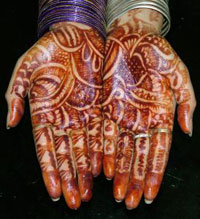Henna Tattoos
Not quite ready to take the plunge? Try henna tattoos!
Mehndi Art

Mehndi
Henna tattoos, also called “mehndi”, are a type of temporary body decoration that developed in India. This traditional art was not thought of as tattooing at all, until quite recently. Rather, mehndi was more like cosmetics – a way of decorating the body for special occasions such as weddings. Anyone who has seen a traditional mehndi design can attest to the fact that the patterns are intricate and stunning. The most common places for mehndi patterns are the hands and feet. Some artists use stencils, but others are able to draw these intricate patterns and apply henna tattoos by hand.
Henna, the Product
Henna is a natural powder that is sometimes also used to dye the hair. When it is made into a past and applied to the skin, it leaves a dye or pigment behind. This gradually fades over a period of days or weeks, depending on the specific henna tattoo product that is used – some seem to be substantially stronger than others.
Nowadays, with the renewed popularity of tattoos in general, henna tattooing has found another application. With a henna tattoo product, you can get a temporary tattoo that is inexpensive, painless, and can look ‘real’. That having been said, the problem with many henna tattoos is that they end up being rather faint in color, have undefined edges, and fade quickly. It really seems to depend on the specific henna tattoo product being used.
Henna Tattoo Designs
While some people (regardless of background) opt for the traditional mehndi art, there are many other choices available. You can select a tattoo design that is much like a real tattoo, the only limitation being that it has to be brown. For example, Celtic or tribal patterns are popular. Interestingly, some young people opt for Christian icons as henna tattoo designs – maybe because young Christians are unlikely to get a real tattoo, but they are attracted to the style nonetheless.
Another innovation is in the placement of henna tattoos. Rather than the traditional mehndi feet or hands, henna tattoos are found in a number of places on the body, much like real tattoos – the arm, shoulder or ankle are all common choices. The pattern is painted on by the tattoo artist, and then the paste is left to dry until it falls off naturally, revealing the tattoo design underneath.
For tattoo aficionados, mehndi art or henna tattoos will probably never take the place of actual tattooing. But if you’re not quite ready to take the plunge, or if you’re underage, or if you want to see how a tattoo will look in a certain location, henna tattoos are fun, inexpensive and virtually risk-free!
Black Henna
Black henna is the name given to a toxic dye that is added to henna in order to make it black. The product that's added is called paraphenylenediamine (PPD) and is traditionally used in black hair dye. The problem is that the body is naturally allergic to PPD. It can cause severe reactions and permanent scarring.